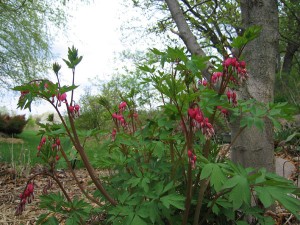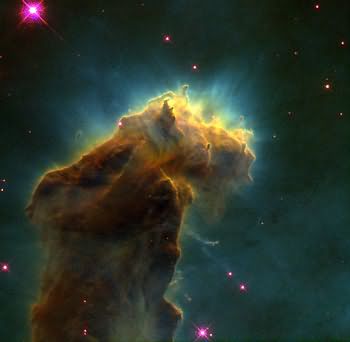Lughnasa Waning Grandchildren Moon
Turning round the star wheel we have come again to the first day of the month named after Augustus Caesar, First Citizen of Rome. In Celtic lands this month was: Welsh–Awst, Scots Gaelic–an Lunasdal and in Irish: Lughnasadh.
Though the coming of Autumn is not visible, the wind tells us it has come. Fujiwara no Toshiyuki
The Japanese word risshu means the first day of Autumn. By solar equinox reckoning we are a good 8 weeks away from that day, yet Toshiyuki’s poem suggests another way to look for the fall of the year. Are there signals in the air, in the plant world, among the animals? Yes, there are. Lughnasa, a cross-quarter holiday in the Celtic calendar, marks the half-way point of the changes from the summer solstice to the fall equinox.
The bees have put away honey all July and August is the month when their honey production wanes. Many flowers and vegetables have already grown, flowered and fruited: iris, daffodil, tulip, lily, dicentra, coral bells, hosta and phlox. The long grasses have seeded as have many of the tall weeds, including the hemp that grows here in abundance. There are stalks, brown stalks, in the garden, the signs of a more general senescence that will over take all the flowers and vegetables as August continues and becomes September. Animal babies have begun to mature, witness the opossum pictured here a few weeks ago.
The main signal of seasonal change though, for me, is the change in the angle of the sun light. By August 20th, the sun’s angle of declination at its highest point in the sky, noon, will be 12 degrees less than the 69 degrees it achieved on June 20th, the summer solstice and the sun’s highest angle at our 45th degree of latitude. This changed angle, subtle at first, becomes obvious as August moves on and creates the tone of seasonal change in advance of temperature and other meteorological signals. We now journey toward the sun’s lowest angle of declination here, 22 degrees, reached at the Winter Solstice on December 21st.
In many webpages you will find confident reference to Lugh as the Celtic sun-god and to Lughnasa as his festival. Maybe. Celtic lore has a number of obstacles to clear understanding. The most difficult obstacles lie in the sources of information that we have for ancient Celtic life. Whatever written information, if any, the Celts left behind have been lost in the wake of the Roman invasions that began in 55 BC with the arrival of Julius Caesar. As a result we always look at the Celts through the eyes of their conquerors. Tacitus, for example, records the story of the Druids and their last stand across the Menai Straits in northwestern Wales. It is Caesar’s accounts of the Gallic Wars (Celtic Wars) that gives us much of the scanty information we have about Celtic religious life.
The next main source of information about the Celts comes from the Roman Catholic Church that overtook and weeded out both the ancient faery faith and the peculiar and attractive version of Christianity that evolved on its own before the Roman Church came. This Celtic Christianity emphasized a close relationship with the natural world and retained practices resonant with the Celtic faery faith.
Nowadays a different, but no less problematic type of interpretation occurs when the neo-pagan community takes up these holidays and puts into them the mythological narratives that appeal most to their sensibility. They can do this, of course, and, in fact, they do, but it does not mean that the interpretation they place on the sacred days have much, if any, congruence with the practices and beliefs of the ancient Celts.
Thus, the Celts and their ancient life exist behind by shrouds of interpretation motivated by ancient political exigency, motivated by medieval religious arrogance and now motivated by contemporary irrational adoration.
Lugh, in other words, is a name put on a Celtic deity by the Romans, who tended to associate the gods of conquered tribes with gods of their own. Lugh came to be equated with Hermes, Mercury to the Romans. We have very little direct information about the Celtic pantheon, though there is some.
What we do know for certain is that on and around August 1, for centuries, Celtic and English peoples celebrated the first fruits of the harvest on a day called Lughnasa. Brian Friel’s wonderful play, Dancing at Lughnasa, gives an excellent account of the holiday as it was still practiced in the early part of the 20th century. As the Burns poem below* attests, part of its celebration included going out into the fields of barley or wheat or rye or whatever, to practice human fertility rites.
Like the rest of the Celtic holidays, Lughnasa involved a week of fairs and markets, a time of celebrations, gatherings of people from various rural areas.
These holidays were and are significant in the daily lives of rural folks in the Celtic Countries and England. The Lammas Meadows are an example. Lugg Meadows in Herefordshire, England are the largest and best preserved of 20 Lammas Meadows in England today, some of which still follow the medieval land tenure system that created them in the first place.
In this system the lord of the manor, who owned the fields, would rent the prime bottom land to those who could afford the rent. Bottom land was the most valuable land in the middle ages because it often had a sandy or rocky bottom with layers of fertile silt on top, creating a well-drained and rich field for growing hay. Hay was critical for it fed the many animals used in farming and in the other work of the manor through the winter.
The fee-holders would mark their holdings with ‘dole stones’, the holding being irregular strips of the bottom land on which they purchased the right to harvest hay. From Candlemas (the Catholic holiday laid over the Celtic celebration of Brigid, the triple Goddess, Imbolc) to Lammas (the Catholic holiday laid over the Celtic Lughnasa) the fee-holders and the Lord kept the Lammas Meadows ‘shut for hay.’ Over this time only the Lord and the fee-holders could enter the land. On Lammas Day, however, the fields would open to the commoner–the person who used the common land–who could browse his animals in them until Candlemas, February 1st of the next year.
The farmer making hay from the Lammas Meadows (see pic) has an interesting graphic about his concept of sustainability. It involves a triple bottom line: social, environmental and economic. Here it is:
from a fascinating website: Wilson’s Almanac
*It was on a Lammas night,
When corn rigs are bonnie,
Beneath the moon’s unclouded light,
I held away to Annie:
The time flew by, wi tentless heed,
Till ‘tween the late and early;
Wi’ sma’ persuasion she agreed
To see me thro’ the barley.
The sky was blue, the wind was still,
The moon was shining clearly;
I set her down, wi’ right good will,
Amang the rigs o’barley
I ken’t her heart was a’ my ain;
I lov’d her most sincerely;
I kissed her owre and owre again,
Among the rig o’ barley.
I locked her in my fond embrace;
Her heart was beating rarely:
My blessings on that happy place,
Amang the rigs o’barley.
But by the moon and stars so bright,
That shone that hour so clearly!
She ay shall bless that happy night,
Amang the rigs o’barley.
I hae been blythe wi’ comrades dear;
I hae been merry drinking;
I hae been joyfu’ gath’rin gear;
I hae been happy thinking:
But a’ the pleasures e’er I saw,
Tho three times doubl’d fairley
That happy night was worth then a’.
Among the rig’s o’ barley.
CHORUS
Corn rigs, an’ barley rigs,
An’ corn rigs are bonnie:
I’ll ne’er forget that happy night,
Among the rigs wi’ Annie.
Robert Burns

 and asters preen themselves as the light begins to fade from the sky and the air cools. Right now the hemerocallis are going strong, creating a lively dance of color in the perennial beds.
and asters preen themselves as the light begins to fade from the sky and the air cools. Right now the hemerocallis are going strong, creating a lively dance of color in the perennial beds. s peak bearing season will commence although we have already had blueberries, strawberries, raspberries, currants, garlic, lettuce, greens, onions, parsnips, beets and sugar snap peas. Ahead of us are tomatoes, green peppers, potatoes, more greens, onions, beets, lettuce, butternut squash, leeks, wild grapes and carrots plus the odd apple. Our orchard has a ways to go before it matures. And I have a ways to go before I can care for the fruit trees in the manner to which they need to become accustomed.
s peak bearing season will commence although we have already had blueberries, strawberries, raspberries, currants, garlic, lettuce, greens, onions, parsnips, beets and sugar snap peas. Ahead of us are tomatoes, green peppers, potatoes, more greens, onions, beets, lettuce, butternut squash, leeks, wild grapes and carrots plus the odd apple. Our orchard has a ways to go before it matures. And I have a ways to go before I can care for the fruit trees in the manner to which they need to become accustomed. don’t know–but no matter, it does speak a truth, at least a truth that speaks to me, to my journey. This Hubble telescope photo of the birthplace of the stars–Star-Birth Clouds in M16: Stellar “Eggs” Emerge from Molecular Cloud–is our own fertile womb, our own site of elemental fecundity, our own inner world changing and becoming the outer reality, the 10,000 things. Fertility lies at the heart of our nature, then, and we need not worry for our nature will see us born and reborn, this time as queens, that time as infant stars, the next time as stellar dust.
don’t know–but no matter, it does speak a truth, at least a truth that speaks to me, to my journey. This Hubble telescope photo of the birthplace of the stars–Star-Birth Clouds in M16: Stellar “Eggs” Emerge from Molecular Cloud–is our own fertile womb, our own site of elemental fecundity, our own inner world changing and becoming the outer reality, the 10,000 things. Fertility lies at the heart of our nature, then, and we need not worry for our nature will see us born and reborn, this time as queens, that time as infant stars, the next time as stellar dust.